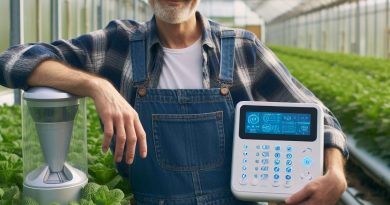Wearable Tech for Cattle: A Deep Dive
Last Updated on March 2, 2024
Introduction
Wearable technology for cattle involves integrating devices onto livestock for monitoring and managing their health and behavior.
The agricultural sector increasingly embraces this innovation, enhancing efficiency and livestock well-being.
Ranchers and farmers employ these technologies to gather real-time data on cattle, ensuring optimal conditions and sustainable practices.
This blogpost explores the profound impact of wearable tech on cattle management, from health tracking to behavior analysis, revolutionizing traditional farming methods.
As these technologies continue to advance, they promise to reshape the future of livestock farming, offering data-driven insights for improved decision-making and overall industry sustainability.
Wearable tech’s transformative potential in modernizing agriculture is underscored by growing interest and adoption, emphasizing efficiency and sustainability.
Benefits of Wearable Tech for Cattle
In recent years, the use of wearable technology in the agriculture industry has gained popularity, particularly in cattle farming.
These innovative devices are revolutionizing the way farmers monitor and manage their livestock, offering a wide range of benefits that improve animal health, welfare, and overall farm productivity.
Here are some of the key advantages of wearable tech for cattle:
Improved health monitoring and early disease detection
With wearable tech, farmers can closely monitor the health of their cattle and detect potential issues at an early stage.
These devices can track vital signs such as heart rate, respiratory rate, and body temperature, providing real-time data that helps identify any deviations from normal patterns.
By identifying health problems early on, farmers can intervene promptly, preventing the spread of diseases and reducing treatment costs.
Effective heat detection and breeding management
Wearable devices equipped with sensors can accurately detect when a cow is in heat, allowing farmers to optimize breeding management.
This technology eliminates the need for visual heat detection, which can be challenging and time-consuming, leading to missed opportunities for successful breeding.
By precisely identifying the ideal time for insemination, farmers can improve breeding efficiency, maximize pregnancy rates, and ultimately increase their herd’s genetic potential.
Enhanced animal welfare and behavior monitoring
Wearable tech also contributes to improved animal welfare by providing insights into the behavior and well-being of individual cattle.
These devices can track movement patterns, grazing behavior, and activity levels, alerting farmers to any abnormal behaviors that may indicate distress or illness.
By addressing these issues promptly, farmers can ensure the well-being of their animals, enhancing their overall welfare and minimizing unnecessary suffering.
Increased overall productivity and efficiency in cattle farming
- One of the most significant advantages of wearable tech for cattle is its impact on farm productivity and efficiency.
- By continuously monitoring vital parameters and behavior, farmers can make informed decisions regarding feed management, herd health, and reproduction.
- This data-driven approach enables them to optimize resources, improve feed conversion rates, reduce veterinary costs, and increase overall profitability.
- Additionally, wearable devices save farmers precious time by automating certain tasks, allowing them to focus on other aspects of their operation.
In short, wearable technology has emerged as a game-changer in the cattle farming industry, offering a wide range of benefits that enhance animal health, welfare, and overall farm productivity.
These innovative devices bring numerous benefits, including improved health monitoring, early disease detection, effective heat detection, and enhanced productivity.
As wearable tech continues to evolve, it holds even greater potential for transforming the way cattle farming operates, ensuring a sustainable and prosperous future for the industry.
Read: Agri Robots: Revolutionizing Precision Agriculture
Types of Wearable Tech for Cattle
GPS-enabled collars for real-time location tracking
GPS-enabled collars are one type of wearable tech used in cattle farming for real-time location tracking.
These collars are equipped with GPS technology, allowing farmers to easily monitor the whereabouts of their cattle.
The GPS-enabled collars use satellites to determine the exact location of each individual animal, providing accurate and up-to-date information.
This technology proves to be invaluable in large cattle herds, where keeping track of every animal can be a daunting task.
Farmers can access the location data through a web-based interface, which displays the real-time positions of their cattle on a map.
This allows them to quickly identify any animals that may have strayed or gotten lost, reducing the time and effort required for search and rescue operations.
Health monitoring devices for vital sign tracking
Health monitoring devices are another type of wearable tech used in cattle farming that focus on vital sign tracking.
These devices, such as smart ear tags or leg bands, continuously monitor the health status of individual cattle.
The devices are equipped with sensors that measure various parameters, including body temperature, heart rate, and respiratory rate.
This data is then transmitted wirelessly to a central system, which analyzes the information and alerts farmers to any abnormalities or signs of illness.
By continuously monitoring vital signs, these devices help farmers to detect potential health issues in their cattle at an early stage, allowing for timely intervention and treatment.
This can significantly reduce the risk of disease outbreaks and ultimately improve overall herd health.
Heat detection and breeding management systems
Heat detection and breeding management systems are wearable tech solutions designed specifically for reproductive management in cattle.
These systems help farmers identify the optimal time for artificial insemination or natural breeding.
The technology typically involves attaching sensors to the cows’ backs or tails, which can detect changes in behavior and body temperature associated with estrus (heat).
The sensors transmit this information to a central system, which analyzes the data and provides alerts to farmers when a cow is in heat.
By accurately detecting heat periods, farmers can ensure timely breeding, leading to increased pregnancy rates and improved breeding efficiency.
This technology also reduces the need for constant visual observation of individual animals, saving farmers time and effort.
Behavior monitoring and alert systems
- Behavior monitoring and alert systems are another type of wearable tech that help farmers monitor the behavior and well-being of their cattle.
- These systems use a combination of sensors and algorithms to detect deviations from normal behavior patterns.
- The sensors, which can be attached to collars or ear tags, monitor various behaviors such as eating, drinking, walking, and resting.
- The data collected is then analyzed by specialized software, which can identify abnormal behaviors indicating potential health issues or distress.
- The system alerts the farmer when it detects abnormal behavior, enabling timely intervention and treatment.
- This technology enables farmers to closely monitor their cattle’s behavior and well-being, ensuring early detection and prevention of health problems.
In essence, wearable tech for cattle encompasses various types of devices that assist farmers in managing their herds more effectively.
From GPS-enabled collars for location tracking to health monitoring devices, heat detection systems, and behavior monitoring tools, these technologies offer valuable insights into the well-being of livestock.
By utilizing these innovations, cattle farmers can improve animal health, increase efficiency, and ultimately enhance the overall productivity of their operations.
Read: Robotics in Farming: A 2024 Guide
Specific Examples of Wearable Tech for Cattle
These specific examples of wearable tech for cattle demonstrate how technology is revolutionizing the way farmers manage their herds.
By utilizing smart ear tags, rumination monitors, collars with GPS and health tracking capabilities, and heat patches, farmers can gather valuable data and make informed decisions about their livestock.
Not only do these technologies improve efficiency and productivity, but they also enhance animal welfare.
Smart ear tags with temperature and activity sensors
One example of wearable technology for cattle is the use of smart ear tags. These tags are equipped with temperature and activity sensors.
The temperature sensors can help monitor the animal’s body temperature, while the activity sensors can track its movements and behavior.
Wearable rumination monitors for feed efficiency tracking
Another type of wearable tech for cattle is rumination monitors. These devices are worn around the neck or attached to the ear of the animal.
They track the animal’s rumination behavior, which can provide insights into its feed efficiency and overall health.
Furthermore, wearable rumination monitors enable farmers to optimize feed efficiency and nutrition management.
By tracking rumination behavior, farmers can identify any deviations or anomalies that might indicate health issues or inadequate nutrition.
Adjust feeding plans based on this information to ensure cattle receive the appropriate nourishment.
Collars with GPS and health tracking capabilities
Collars equipped with GPS and health tracking capabilities are also used in the cattle industry.
These collars allow farmers to keep track of their cattle’s location, which can be helpful for monitoring their grazing patterns and ensuring their safety.
Additionally, the health tracking features can provide valuable data on key parameters such as heart rate and respiratory rate.
Heat patches for accurate heat detection and breeding management
- Heat detection is crucial for successful breeding management in cattle.
- Wearable heat patches can be attached to the animals’ hindquarters, enabling accurate heat detection.
- These patches monitor changes in body temperature and movement patterns, alerting farmers to optimal breeding times.
In summary, wearable tech for cattle is transforming the way farmers manage their herds.
The use of smart ear tags, rumination monitors, GPS-enabled collars, and heat patches allows for more efficient and effective animal management.
These technologies not only improve productivity but also enhance animal welfare by enabling early detection of health issues and optimizing feed efficiency.
As the agriculture industry continues to embrace technological advancements, the future looks promising for cattle farmers and their herds.
Read: Automation in Agriculture: Pros & Cons

Implementation and Challenges
Consideration of farm size and infrastructure
- Before adopting wearable tech for cattle, farmers must assess if their farm is suitable.
- Factors like farm size, existing infrastructure, and layout can impact the implementation process.
- Large farms may need more sensors and tracking devices, while smaller farms can start with fewer.
- The availability of proper internet connectivity is essential for seamless data transmission from wearables.
Cost analysis and return on investment
- Farmers must perform a cost-benefit analysis to determine if investing in wearable tech is economically feasible.
- The initial cost of devices, installation, and maintenance should be compared with potential benefits and savings.
- Cost savings may include reduced labor, improved efficiency, better disease management, and higher productivity.
- Return on investment should be assessed by considering long-term benefits and potential revenue growth.
Integration with existing farm management systems
- Wearable tech for cattle should seamlessly integrate with existing farm management systems.
- Compatibility with software and hardware used for tasks like inventory, feeding, and medical records is crucial.
- Integration allows for efficient data exchange, centralized monitoring, and streamlined decision-making processes.
- Compatibility issues can be addressed by working with tech providers or seeking professional help if needed.
Data privacy and security concerns
- Wearable tech generates vast amounts of sensitive data, raising concerns about privacy and security.
- Farmers must ensure that data collected from wearables is stored securely and protected from unauthorized access.
- Compliance with data protection regulations and industry best practices is crucial.
- Choosing reputable tech providers and implementing strong encryption measures can enhance data security.
By carefully considering these implementation factors and addressing challenges, farmers can successfully adopt wearable tech for cattle.
The benefits it offers, including improved efficiency, better disease management, and higher productivity, make it a compelling investment.
The integration of technology into the agricultural sector is revolutionizing farming practices and paving the way for a more sustainable and data-driven future.
Read: Smart Greenhouses: Tech Explained
Find Out More: Futuristic Barns: Automated Feeding Systems
Future Development and Potential
Advances in Wearable Tech Technology for Cattle
Wearable technology for cattle is poised for remarkable advancements, with ongoing innovations promising increased precision and functionality.
Engineers and researchers continually refine existing devices, ensuring more accurate data collection and comprehensive health monitoring for livestock.
Potential for Big Data Analytics and Predictive Modeling
As the volume of data generated by wearable tech increases, the potential for big data analytics and predictive modeling in cattle farming becomes evident.
Farmers can harness this wealth of information to make informed decisions, optimize resource allocation, and anticipate herd health trends.
Enhanced Cattle Farming Practices and Sustainability
The integration of wearable tech in cattle farming heralds a new era of precision agriculture.
Farmers can fine-tune their practices based on real-time insights, optimizing feeding schedules, disease prevention, and breeding programs.
This precision contributes to sustainable farming practices by minimizing resource waste and maximizing efficiency.
Possible Implications for Animal Welfare and Protection Laws
- The advent of wearable tech in cattle farming raises important considerations for animal welfare and protection laws.
- As these technologies become more prevalent, regulators may need to adapt existing laws or introduce new ones to ensure ethical and humane use.
- The focus will likely shift to balancing technological innovation with ethical treatment standards.
In a nutshell, the future of wearable tech for cattle holds great promise, driving innovation in agriculture and reshaping traditional farming practices.
With continuous technological advancements, the agricultural industry is on the cusp of a data-driven revolution that can enhance efficiency, sustainability, and animal welfare.
As wearable devices become more sophisticated, their potential to transform cattle farming into a technologically advanced and ethically sound industry becomes increasingly tangible.
Farmers and researchers alike eagerly anticipate the positive impacts these innovations will bring, marking a significant chapter in the ongoing evolution of agriculture.
Uncover the Details: Big Data: Transforming Agriculture
Conclusion
Wearable technology for cattle has immense benefits for both farmers and the animals.
It allows for real-time monitoring and data collection, leading to improved health and productivity.
Also, it enables early detection of diseases and helps in making informed decisions regarding breeding and nutrition.
It is essential for farmers to embrace wearable tech for cattle to modernize their practices and increase profitability.
By investing in these technologies, farmers can streamline their operations, save costs, and ensure the well-being of their livestock.
The importance of staying updated with the latest advancements in agricultural technology:
Advancements in wearable tech for cattle are constantly being made.
It is crucial for farmers to stay informed about the latest developments to make wise choices for their businesses.
Attending conferences, subscribing to industry newsletters, and networking with experts can help farmers stay ahead.


